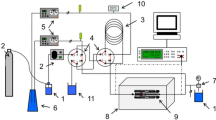Abstract
The electrical conductivities of hydrochloric acid and potassium chloride in water have been measured in the concentration range of 3×10−4–10−3 moles-dm−3 at 0°C up to 3500 bar. The limiting molar conductance (Λ0) for HCl increases with increasing pressure, while Λ0(KCl) has a maximum around 1700 bar. The excess conductance of hydrogen ion [λ E0 =Λ0(HCl)−Λ0(KCl)] increases with increasing pressure. Its pressure dependence indicates that the reorientation of water molecules, which is the rate-determining step in the proton jump, becomes faster at higher pressure. This anomaly is attributed to the distortion with pressure of the hydrogen bonds in water.
Similar content being viewed by others
References
B. E. Conway, J. O'M. Bockris, and H. Linton,J. Chem. Phys. 24, 834 (1956).
M. Nakahara and J. Osugi,Rev. Phys. Chem. Jpn. 47, 1 (1977).
J. Jonas, T. DeFries, and D. J. Wilber,J. Chem. Phys. 65, 582 (1976).
T. Shedlovsky,J. Am. Chem. Soc. 54, 1141 (1932).
M. Ueno, M. Nakahara, and J. Osugi,Rev. Phys. Chem. Jpn. 47, 25 (1977).
M. Nakahara, K. Shimizu, and J. Osugi,Rev. Phys. Chem. Jpn. 40, 1 (1970).
G. C. Benson and A. R. Gordon,J. Chem. Phys. 13, 473 (1945).
C. E. Weir,J. Res. Natl. Bur. Stand. 53, 245 (1954).
K. R. Srinivasan and R. L. Kay,J. Chem. Phys. 60, 3645 (1974).
G. S. Kell and E. Whalley,Philos. Trans. R. Soc. London Ser. A.258, 565 (1965); G. S. Kell,Water. A Comprehensive Treatise F. Franks, ed., Vol. 1 (Plenum Press, New York, 1972), Chapter 10.
J. B. Cappi, Ph.D. Thesis, London University (1964).
M. Ueno, K. Shimizu, and J. Osugi,Rev. Phys. Chem. Jpn. 43, 33 (1973).
M. Nakahara and J. Osugi,Rev. Phys. Chem. Jpn. 42, 12 (1972).
R. A. Robinson and R. H. Stokes,Electrolyte Solutions (Butterworths, London, 1965), Chapter 5.
L. A. Woolf,J. Chem. Soc. Faraday Trans. 1 71, 784 (1975).
R. A. Horne, B. R. Myers, and G. R. Frysinger,J. Chem. Phys. 39, 2666 (1963).
E. Whalley,J. Chem. Phys. 63, 5205 (1975).
G. E. Walrafen,J. Solution Chem. 2, 159 (1973); G. E. Walrafen and M. Abebe,J. Chem, Phys. 68, 4694 (1978).
F. H. Stillinger and A. RahmanJ. Chem. Phys. 61, 4973 (1974).
D. Eisenberg and W. Kauzmann,The Structure and Properties of Water, (Oxford University Press, London, 1969).
G. J. Wilson, R. K. Chan, D. W. Davidson, and E. Whalley,J. Chem. Phys. 43, 2384 (1965).
Author information
Authors and Affiliations
Rights and permissions
About this article
Cite this article
Ueno, M., Nakahara, M. & Osugi, J. Effect of pressure on the conductivities of HCl and KCl in water at 0°C. J Solution Chem 8, 881–886 (1979). https://doi.org/10.1007/BF00644884
Received:
Revised:
Issue Date:
DOI: https://doi.org/10.1007/BF00644884



